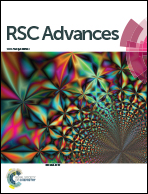Synthesis, characterization and the effect of temperature on different physicochemical properties of protic ionic liquids†
Abstract
In this work, eleven protic ionic liquids (PILs) containing different cations and anions were prepared and their physicochemical properties were measured. The structures of all the PILs were confirmed using NMR, and elemental analysis (CHNS) was carried out. The physicochemical properties such as density, surface tension, viscosity and thermal degradation behaviour were measured, and the effect of the cations/anions was investigated. The density and viscosity were measured within the temperature range of 293.15–373.15 K at atmospheric pressure. The thermal expansion coefficient values were calculated from the density data. Surface tension was measured in the temperature range of 293.15 to 353.15 K and the values were used to estimate the surface entropy and enthalpy of the ionic liquids at 303.15 K. The boiling and critical temperature are also estimated according to the Eötvos and Rebelo methods. The refractive indices were measured within the temperature range of 293.15 to 323.15 K. The thermal gravimetric analysis was performed in the temperature range of 373.15–773.15 K.


 Please wait while we load your content...
Please wait while we load your content...